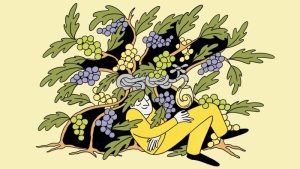Hallucinogens, hexes and healing — inside the witch’s garden
Unlock the Editor’s Digest for free
Roula Khalaf, Editor of the FT, selects her favourite stories in this weekly newsletter.
It is October, and Halloween will soon be upon us. I will celebrate by slathering on some flying ointment, mounting my broomstick and performing some low-level aerobatics.
If only.
Even Waitrose, a reliable supplier of niche products, does not stock flying ointment. To make it, you need mandrake root. This, too, is hard to source.
UK garden centres rarely sell toxic plants associated with magic. But they have many lethally poisonous wares that lack local occult baggage — laburnum or angel’s trumpets, for example. The dichotomy reflects the demotion of plants in western culture from powerful, mysterious organisms to passive garden ornaments.
Mandrakes are Mediterranean plants with purple flowers. The roots vaguely resemble gnarled, naked people. Mythically, they emit lethal screams when uprooted. Harry Potter and his pals wore ear protectors when repotting them.
The movie sequence piqued my interest. The mandrake seedlings I obtained from a specialist nursery did not so much as squeak when I planted them. As they pushed out cabbage-like leaves, I pondered the relationship between humans and poisonous plants. Many of these are members of the vast Solanaceae family that includes potatoes and tomatoes.
So-called “witching herbs” — mandrake, deadly nightshade and henbane — contain chemicals that disrupt human nerve signals. These potentially lethal “tropane alkaloids” can be anaesthetic in small doses and trigger hallucinations in larger amounts. Flying ointment is not supposed to free users’ bodies from gravity, but their minds from reality.
Taking hallucinogens has always struck me as like jamming a screwdriver into your PC’s motherboard in hopes it will trigger interesting short circuits. You can replace a hard drive. You cannot replace your brain.
I am sentimentally attached to my cerebrum and try to look after it. My mandrakes are not homegrown trip-fodder but botanical marvels. They fulfil the same function at Oxford Botanic Garden, where they have flourished for over 400 years. “It’s a plant that resonates with deep time and transcends generations,” says Chris Thorogood, head of science at the garden and author of botanical manifesto Pathless Forest. “A twinkle comes into people’s eyes when they see our mandrakes.”
Women in Renaissance Italy achieved similar results by dilating their pupils with the juice of deadly nightshade. Hence its synonym “belladonna”. The effects include blurred vision. Juliet must have needed to know where Romeo was loitering to bump into him accidentally on purpose. Otherwise she could have found herself myopically flirting with a statue in the piazza.
I nervously grew belladonna one year. The berries were glossy black and wickedly alluring. I destroyed the plant when kids came to stay with us. The main active ingredient is atropine, named after the Greek Fate that cuts the thread of each human life. Drops containing atropine are sometimes still used in medical eye examinations. Hyoscyamine, a chemical produced by henbane, features in some pharmaceutical treatments for gut problems and symptoms of Parkinson’s Disease.
There is now a yawning cultural gulf between the qualified physician and the unregulated herbalist. But the practice of the former was built on the knowledge of the latter. Dorset herbalists Fiona Heckels and Kazz Goodweather, aka The Seed SistAs, explore that knowledge in a recently published “grimoire”, or spell book, Poison Prescriptions. Goodweather says: “We want people to connect with witching plants by growing them and understanding their rich history and magic.”
Drugs with psychoactive properties can be very dangerous. In the UK, supplying them is generally illegal. Such herbal treatments can usually only be sold by a registered pharmacy or under a doctor’s prescription.
The risks did not stop an acquaintance of mine, an economist struggling with alcohol abuse, from undertaking psychotropic therapy. He eschewed ayahuasca, which is popular among American hipsters, in favour of iboga administered by a traditional African herbalist. After horrendous vomiting, he experienced a moment of transcendence surpassing anything he had felt while modelling inflation.
He has not touched booze since. But potions of iboga, a rainforest shrub used in tribal initiations, can easily kill recipients. Western medical researchers have so far failed to develop it as a safe anti-addiction drug.
The witchy Seed SistAs and the scientific Thorogood agree that poisonous plants remind us to respect nature. He says: “We think of plants as mute and immobile, dull and defenceless. But they have a chemical arsenal to protect them.” If you cultivate any poisonous plant, wear gloves and avoid ingesting any part of it. Keep children and pets away.
As for New Age witchery, it merits as much broad-minded tolerance — and gentle scepticism — as any faith. Devotees view Halloween’s flying crones as figures of hate and ridicule used to justify historic persecutions.
It is all too easy to mock, as a colleague of mine found. As a cub reporter for a US newspaper, he was dispatched to cover a witches’ convention in the midwest. When the proceedings of the day were concluded, he joined the sorceresses and wizards in the bar. A blizzard was raging outside.
“I don’t know how I’m going to get back to Buffalo in this weather. The roads are all blocked,” one witch complained.
“Why don’t you just hop on your broomstick?” the reporter suggested.
He was lucky she only slapped him. She could have turned him into a frog.
Find out about our latest stories first — follow @ft_houseandhome on Instagram
#Hallucinogens #hexes #healing #witchs #garden




